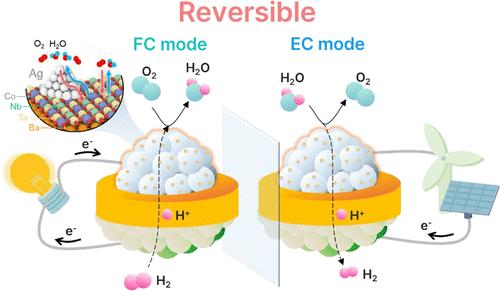Promotion of Reversible Fuel-Power Generation in Protonic Ceramic Electrochemical Cell via Water-Mediated Ex-Solution
IF 18.2
1区 材料科学
Q1 CHEMISTRY, PHYSICAL
引用次数: 0
Abstract
It is indicated that water can be an active motif for nanoparticle ex-solution. Yet, only a handful of studies are available, if possible, limited to the elemental composition of Ba(Co,Fe,Zr,Y)O3−δ as a mother oxide. Here we prove the versatility of water-mediated ex-solution by expanding the perovskite palettes. Among these, our selected composition (i.e., Ag ex-solved Ba0.95Ag0.05Co0.8Nb0.1Ta0.1O3-δ, e-BACNT) is demonstrated as an oxygen electrode material for protonic ceramic electrochemical cells, promoting efficient reversible fuel-power generation. Thereby, a peak power density of ∼1.81 W cm–2 and water-splitting current density of ∼2.93 A cm–2 at 1.3 V and 650 °C are achieved within a single cell. Apart from its notable cell performances, this work unveils new opportunities for creating functional metal-oxide heterointerfaces.

以水为介质的前溶液促进质子陶瓷电化学电池可逆燃料发电
结果表明,水可以作为纳米粒子脱溶的活性基序。然而,只有少数研究是可用的,如果可能的话,仅限于元素组成Ba(Co,Fe,Zr,Y)O3−δ作为母氧化物。在这里,我们通过扩展钙钛矿调色板证明了水介导的前溶液的多功能性。其中,我们选择的组合物(即Ag - ex-solved Ba0.95Ag0.05Co0.8Nb0.1Ta0.1O3-δ, e-BACNT)被证明是质子陶瓷电化学电池的氧电极材料,促进了高效的可逆燃料发电。因此,在1.3 V和650°C下,在单个电池内实现了约1.81 W cm-2的峰值功率密度和约2.93 a cm-2的水分解电流密度。除了其显著的电池性能外,这项工作还揭示了创造功能性金属氧化物异质界面的新机会。
本文章由计算机程序翻译,如有差异,请以英文原文为准。
求助全文
约1分钟内获得全文
求助全文
来源期刊

ACS Energy Letters
Energy-Renewable Energy, Sustainability and the Environment
CiteScore
31.20
自引率
5.00%
发文量
469
审稿时长
1 months
期刊介绍:
ACS Energy Letters is a monthly journal that publishes papers reporting new scientific advances in energy research. The journal focuses on topics that are of interest to scientists working in the fundamental and applied sciences. Rapid publication is a central criterion for acceptance, and the journal is known for its quick publication times, with an average of 4-6 weeks from submission to web publication in As Soon As Publishable format.
ACS Energy Letters is ranked as the number one journal in the Web of Science Electrochemistry category. It also ranks within the top 10 journals for Physical Chemistry, Energy & Fuels, and Nanoscience & Nanotechnology.
The journal offers several types of articles, including Letters, Energy Express, Perspectives, Reviews, Editorials, Viewpoints and Energy Focus. Additionally, authors have the option to submit videos that summarize or support the information presented in a Perspective or Review article, which can be highlighted on the journal's website. ACS Energy Letters is abstracted and indexed in Chemical Abstracts Service/SciFinder, EBSCO-summon, PubMed, Web of Science, Scopus and Portico.
 求助内容:
求助内容: 应助结果提醒方式:
应助结果提醒方式:


